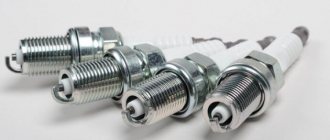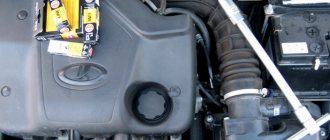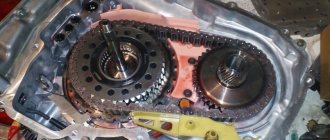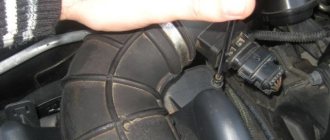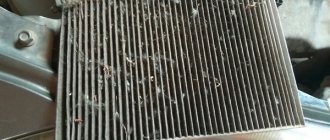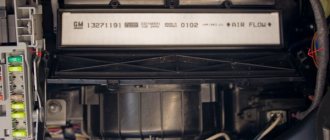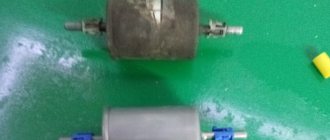Production of the third generation Opel Astra began in March 2004. Officially, its production ended in September 2009, but in Russia the family was produced until 2014 under the name Astra Family. The base was the Delta platform, also used in the production of the Zafira line of cars.
The engines were four-cylinder with a volume of up to 2.4 liters and a potential of up to 240 hp. But the most popular is the Z16XER with a volume of 1.6 liters. Boxes - depending on the on-board power plant: 5/6-speed manual, 4/6-speed automatic, 5-speed Easytronic robot.
When replacement is required
Following the technical regulations, the replacement procedure should be carried out every ten thousand kilometers. At the same time, components installed directly at the factory can last you up to 75 thousand kilometers.
The service life also directly depends on the spark plugs themselves: for example, iridium ones can last up to 100 thousand kilometers, and regular ones - a maximum of 30.
Signs that it is time to replace the spark plugs on an Opel Astra and that they are failing will be:
The presence of one or more of the above “symptoms” is a sign that it’s time to purchase new consumables.
Choice
The efficiency of ignition of the mixture in the cylinder is affected by:
All existing candles are conventionally divided into unified, medium, “cold” and “hot”. They are also:
The choice of consumables is not as simple as it seems at first glance. Let's take a closer look at the original and analog components.
Original
Most car owners prefer original SZ. Their cost varies from three hundred rubles and more per piece.
Each of the Opel lines is equipped with its own type of components, for example:
For example, for the z16xer engine, original spark plugs from Opel under article number 1214031 are suitable. The Z18xer is usually equipped with products from NGK under the serial number ZFR5F-11.
The components necessary for stable operation depend on the gap; too small or large a value can lead to rapid failure of the SZ.
Analogs
If you don’t want to overpay, then you can take a closer look at analogues that are not inferior to factory SZ in terms of performance characteristics:
| Brand | vendor code | Price, rub.) |
| NGK | BPR6ES | 250-400 |
| Denso | K20PRU | 150-300 |
| Bosch | 242235668 | 150-300 |
| NGK | 7822 | 100-250 |
| Denso | KJ16CRL11 | 175-300 |
Please note that even inexpensive components are often counterfeited. Therefore, before purchasing, carefully check the box and the candle itself for any extraneous markings, check the colors with the photographs from the catalog. This way you will save yourself from buying a low-quality Chinese copy, which will fail after 3-5 thousand kilometers of the vehicle.
Spark plugs opel astra h z18xer
Good day to everyone, dear subscribers, astravods and those simply coming to visit. A lot of things have accumulated lately, but I’ll probably start with the spark plugs. As I already described in my previous Logbook, in the fight to reduce fuel consumption at idle, NGK ZFR5F-11 spark plugs were purchased, and as was actually clear from the same bulletin board, these spark plugs did not bring the expected result. The consumption was still 0.9 l/hour. As a result, after using these spark plugs for a month and a half, I decided to purchase Bosch spark plugs 0 242 229 699
. I ordered these candles from Exist at a price of 200 rubles/piece. I think what the hell is not joking, what if! The candles arrived in 3 days, made in Germany. I changed them there near the store. The factory clearance on them was 0.95 mm. Moreover, it was absolutely the same on everyone; naturally, I didn’t touch it. I turned it on, started it, warmed it up and went to look at the BC, with the feeling that I wouldn’t see anything new there, but imagine my surprise when, instead of the figures I was already familiar with 0.9-1.1 l/hour, I saw 0.7- 0.8 l/h. My surprise knew no bounds. To celebrate, I stopped by the store)))). The engine, just like with the previous spark plugs, runs smoothly, the idle is crisp, and the response to the gas pedal is also excellent. In general, I concluded that it’s all about the filling of the insides of the candle. I wonder what NGK and Denso are made of if they have such fuel consumption? 1. Spark plugs DENSO VK16 vs GM. 2. Spark plugs DENSO K20TT vs DENSO VK16. 3. Spark plugs NGK ZFR5F-11 vs DENSO K20TT. Here's some more information: The source is here!
Spark plugs for engines A16 (18) XER/Z16 (18) XER/F16 (18) D4
I decided to summarize the information on spark plugs for A16 (18) XER/Z16 (18) XER/F16 (18) D4
, installed on a huge number of GM models sold and sold in the CIS.
Original for A16 (18) XER (F16D4) GM 55565219 (Opel 12 14 016)
and warmer ones, original for
Z16 (18) XER GM 93176801 (Opel 12 14 031)
.
Analogs:
DENSO - KJ20CR-L11
(regular),
K20TT
(thin gap 1mm),
IK20L
(iridium, normal service life),
VK20
(iridium + platinum side, extended service life).
Warmer"
option
- KJ16CR-L11
(regular),
K16TT
(thin gap 1mm),
IK16L
(iridium, normal life),
VK16
(iridium + platinum side, extended life)
NGK-ZFR6V-G
(8894) (copper),
ZFR6FIX-11
(6441) (iridium),
ZFR6FIX-11P
(3064) (iridium center + platinum side)
A “warmer”
version
of NGK - ZFR5F-11
(2262),
ZFR5FIX-11
(2477) (iridium),
ZFR5FIX-11P
(4620) (iridium center + platinum side)
BOSCH - 0 242 236 542
(FR7LCX+)(copper electrodes),
0 242 236 558
(FR7LPX)(platinum electrodes)
A “warmer”
version of
BOSCH - 0 242 229 699
(FQR8LEU2) (gap 0.9 mm)
an even “warmer”
, but widely used, option
BOSCH - 0 242 225 580
(FR9LCX)(copper)
Beru - Z 203
(“warm”, gap 0.9mm), set of 4 spark plugs – Z 203 SB
Autolite - XP5224
(iridium center + platinum side), gap 1.1mm
Both options are suitable in terms of heat, but the first, cooler one, comes original from the factory, while the second, “hotter” one, has been in use for a good dozen years for hundreds of thousands of asters and other Corsos with insignia and zafirs, with XER series engines. Theoretically, “hotter” candles should last slightly less. Also, theoretically, fans of high speeds and highway runs will be more suitable for “cooler” versions of spark plugs, and for people who drive their cars mainly in city traffic jams, “hotter” ones that clean better at lower temperatures and loads. In practice, both options have positive experience and car enthusiasts should not think too much about this.
Astra H 2007 Z18XER engine. NGK spark plugs. Which?
We have an Astra H Caravan Z18XER 2007. Mileage 40 thousand km.
The spark plugs were changed at an unofficial service center. Installed NGK ZFR5F
.
The car seems to be driving fine. But I just came across information on the Internet that the Z18XER requires slightly different spark plugs - NGK ZFR5F-11
.
Judging by the NGK website, the difference between the spark plugs they supplied me and the “correct” ones is only in the gap between the electrodes.
In NGK ZFR5F the gap is 0.7 mm
, in NGK ZFR5F-11 the gap is
1.1 mm
.
Question. What to do? Should I still replace the spark plugs with the “correct” ones? Or quit and drive like this? What are the consequences of a reduced gap?
VerSerj
And what?
What conclusion can you draw after reading this thread? I saw this:
If I remember correctly, there should be models of spark plugs for XER. Our gap is formally 0.9-1.1, I think 0.7 will not be enough.
In general, the search rules.
RS-232 Bachelor of ASTRAnomy quote
Registered: 01/04/2008 Messages: 1282 From: Society for Responsible Consumption Warnings: 1
MessageAdded: Tue Feb 02, 2010 22:55 Message title: Reply with quote Guys, let me generalize. 90% of problems associated with the ignition coil are the gap in the spark plugs. I keep an eye on the statistics. The main influx is in winter. My proposal is this -replacement of spark plugs once a year before winter. Tomorrow I’ll add my thoughts. _________________
This man knows what he is saying and I would listen to his opinion.
Somehow I don’t really want to run into such a topic https://astraclub.ru/search.html?cx=p. t%3D51323#1279
Look, there are a lot of them.
The Opel Astra has been produced since 1991 and is a continuation of the Opel Cadet. The car is available with gasoline and diesel engines. There are currently five generations of Astra. The most common ones in Russia are the first (F), second (G), third (H) and fourth (J), which is why they will be mentioned in this article.
Spark plugs for Astra differ depending on engines and generations. Moreover, in some generations there are complete similarities of candles. The supplier of original spare parts is General Motors (GM). There are quite a few manufacturers of the originals, and they varied slightly depending on the generation. The original Astra F and G almost always had spark plugs from Bosch or Beru, the third one had NGK, Champion, Beru, and the fourth one had Champion, NGK, AC Delco or Beru. All originals are supplied in original packaging from GM or Opel.
Spark plug gap
The spark plug gap is the distance between the electrodes that meets the established standards. To ignite the fuel mixture, it is necessary to strictly maintain the distance between the upper and lower elements to create a spark. Violation of the recommendations leads to unstable operation of the engine, jerking when the speed increases while the car is moving.
The gap between the spark plug electrodes on an Opel Astra must be no less than 0.9 and no more than 1.2 mm, otherwise the spark plug will not work correctly, which will lead to unstable engine operation.
The electrodes produce a strong spark, but not enough to ignite the liquid. If the distance increases, ranging from 1.3 mm and above, then this indicates wear of the device. Lack of contact between parts will not result in the expected ignition of the air-fuel mixture.
Spark plugs for Astra F and G
Gasoline Opel Astra F with engines 1.4, 1.6, 1.8, 2.0 and generation G with engines 1.2, 1.4, 1.6, 1.8, 2.0, 2.0 Turbo had a lot in common. In particular, the same spark plugs under article number 1214000 were installed on both cars, in all trim levels and with all engines. By the way, they are also installed on some trim levels of the Opel Corsa C. These are ordinary nickel spark plugs with two side electrodes, with a torque tightening 22 Nm.
The dimensions of the original spark plugs for Astra F and G are shown in the table below.
| Thread / thread length, mm | Key size | Gap, mm | Heat number* | Center electrode material |
| M14×1.25 / 19 | 16 | 0.8 | 6 | Nickel |
* hereinafter in the article the nomenclature of the NGK company is indicated
Popular substitutes for this spark plug are presented below.
| Manufacturer | vendor code | Price, rub (for 1 piece) |
| Bosch | 0242229654 | 170 |
| Denso | K20TT | 150 |
| Francecar | FCR211057 | 100 |
In addition to the usual nickel analogues, you can install more advanced iridium spark plugs. They last on average 3 times longer and provide better engine performance. For Opel Astra 1st and 2nd generations, the most popular and frequently used iridium spark plug model is Denso IK20TT, price - 610 rubles / piece.
Spark plugs for Opel Astra H
Opel Astra H (third generation) has a wider range of spark plugs. The car was equipped with gasoline engines with volumes of 1.4, 1.6, 1.8 and 2.0. Spark plugs differ depending on the volume and modification of the power unit.
It is worth mentioning right away that on all Astra gasoline engines of this generation, spark plugs come with a short thread and a tightening torque of 22 Nm. Also, the manufacturer installed ordinary nickel spark plugs with one side electrode on almost all engines; they differ only in some parameters (more details in the table below). The exceptions are the 1.6-liter A16LET and Z16LET, as well as the 2-liter Z20LEH engine, which were equipped with platinum spark plugs from the factory, also with one ground electrode.
The original article numbers and sizes of candles for Astra H are presented in the table.
| vendor code | Engine | Thread / thread length, mm | Key size | Gap, mm | Heat number* | Center electrode material |
| 93176801 | Z14XEL, Z14XEP, Z16XEP, Z16XE1, Z18XE, (A16XER, Z16XER) – until 2010, (A18XER, Z18XER) – until 2013 | 14×1,25 / 19 | 16 | 0.8 | 5 | Nickel |
| 55565219 | A16XER, Z16XER – after 2010 | 14×1,25 / 19 | 16 | 0.9 | 6 | Nickel |
| 25193473 | (A18XER, Z18XER) – after 2013 | M14×1.25 / 19 | 16 | 0.9 | 6 | Nickel |
| 55564763 | A16LET, Z16LET | 14×1,25 / 19 | 16 | 0.7 | 6 | Platinum |
| 55562534 | Z20LEH | 14×1,25 / 19 | 16 | 0.7 | 6 | Platinum |
| 93180485 | Z20LEH | 14×1,25 / 19 | 16 | 0.8 | 5 | Nickel |
Substitutes from other manufacturers, which are most often used on this car, are presented below. Some spark plugs have common analogues, since they are either identical in size and parameters, or the differences are very small.
| Manufacturer | vendor code | Price, rub (for 1 piece) |
| Analogs for candles 93176801 | ||
| NGK | 2262 | 160 |
| Denso | KJ16CRL11 | 160 |
| For 55565219 and 25193473 | ||
| Bosch | 0242225580 | 150 |
| Denso | KJ20CRL11 | 170 |
| For 55564763 and 55562534 | ||
| Denso | IK20TT | 610 |
| Bosch | 0242236564 | 350 |
| For 93180485 | ||
| Denso | KJ16CRL11 | 160 |
| Champion | OE 198/T10 | 220 |
In addition to the usual models, for spark plugs 93176801 and 93180485 you can use an analogue with an iridium central electrode - Denso IK16TT (price - 640 rubles / piece), and for 55565219 and 25193473 - Denso IK20TT (cost 610 rubles / piece).
What candles should I put?
The most popular Opel Astra spark plugs are the z16xer and z16xep models. Let's look at the replacement process using the z16xer model as an example. As reviews from car owners show, these SZ perform their functions perfectly and generally work reliably throughout their entire service life. In addition to these SZ, the use of SZ Bosch, Champion, NGK, Denso, etc. is allowed in Opel Astra H engines.
We recommend: How to flush a car’s cooling system on your own, including using a folk remedy
Spark plugs for Opel Astra J
Opel Astra J (fourth generation) was equipped with gasoline engines with volumes of 1.4, 1.6, 2.0. Spark plugs are different from engines in many ways. On this car, some trim levels are equipped with the same spark plugs as the previous generation (Astra H), since they used the same engines.
Astra J with engines 1.4 (A14XEL, A14XER), 1.6 (A16XER, 1.6 115 hp) and 1.8 (A18XER) had spark plugs with article number 55565219. This is the same spare part as on the previous generation of cars with A16XER engines, Z16XER – after 2010. Therefore, their sizes and analogues are the same. Therefore, they will not be mentioned further in this section.
Gasoline 1.4 Turbo (A14NEL, A14NET) were equipped with iridium spark plugs from the factory, with one ground electrode, and a tightening torque of 28 Nm. 1.6SIDI engines (A16XHT, A16SHT) were also equipped with single-pin iridium spark plugs, but with a longer thread and a tightening torque of 25 Nm.
On Astra 4 with 1.6 engines (Turbo, A16LET), spark plugs 55564763 were installed. They are the same as on the previous (third) generation of cars, which had the same engines. These candles are not mentioned further in the section.
The Opel Astra J with a two-liter A20NFT engine from the manufacturer was equipped with iridium spark plugs with one side electrode, which had a tightening torque of 25 Nm.
More details about sizes and original articles in the table. Spark plugs similar to those installed in the previous generation are not listed here.
| vendor code | Engine | Thread / thread length, mm | Key size | Gap, mm | Heat number* | Center electrode material |
| 55576026 | 1.4 (A14NEL, A14NET) | M14x1.25/19 | 16 | 0.7 | 7 | Iridium |
| 55590949 | 1.6 (A16XHT, A16SHT) | M14×1.25 / 25 | 14 | 0.8 | 8 | Iridium |
| 12620540 | 2.0 (A20NFT) | M14×1.25 / 25 | 16 | 1 | 6 | Iridium |
Popular substitutes for these candles are further on the list.
| Manufacturer | vendor code | Price, rub (for 1 piece) |
| Analogues for 55576026 | ||
| NGK | 91039 | 760 |
| Bosch | 0242240707 | 450 |
| For 55590949 | ||
| NGK | 91970 | 630 |
| For 12620540 | ||
| Denso | ITV16TT | 620 |
| NGK | 5476 | 600 |
When to change spark plugs on Astra F, G, H, J?
According to the maintenance regulations for Opel Astras (F, G, H, J), spark plugs with a nickel electrode must be changed every 30 thousand km. In reality, their service life, as many drivers say, does not exceed 20 - 25 thousand km. But iridium and platinum spare parts last 60 thousand km without problems, and in many cases longer (especially iridium ones).
Source
Timing for replacing spark plugs
The service life of the designated vehicle part depends on the ignition system. A large number of modern engine units operate with a “lean” combustible mixture. This happened due to requirements for the efficiency of cars, as well as to reduce emissions of harmful substances into the atmosphere. Working in the presented mode reduces the service life of the designated car part to fifteen thousand kilometers. Of course, this figure is not absolute. The service life of spark plugs can be reduced due to the use of a low-quality air-fuel mixture by the car owner. It is also necessary to note that before the onset of the cold season, the vehicle owner is recommended to check the spark plugs and, if necessary, change them. This should be done in order to be sure that the car engine will start in the morning.
Related Posts
- Jamming traffic police cameras is an easy way to save on fines
In addition, the car owner can determine that it is time to change the spark plugs on an Opel Astra N car based on certain signs.
List of signs:
- Fuel consumption has increased significantly (for example, from ten liters per hundred kilometers to fourteen liters);
- It picks up speed slower than usual;
- Loss of engine power;
- The motor unit is tripping - this means that during operation it rattles and functions in “waves”;
- Due to the symptom indicated above, excess vibrations are transmitted into the vehicle interior, which are easily noticeable;
- When starting an internal combustion engine, the car owner encounters difficulties.
Selecting spark plugs?
A lot of time has passed since spark plugs were invented and began to be used, however, due to the constant development of the auto industry, spark plugs are also being improved. The designated car parts are used for all types of internal combustion engines.
Each internal combustion engine has its own type of spark plug:
- For engines running on gasoline, spark engines are required;
- For turbojet engines - arc;
- For certain carburetor engines and diesel engines, a glow plug is used;
- Gas turbine internal combustion engines require the use of surface discharge spark plugs.
Motorists who own a vehicle with a gasoline engine are required to purchase spark plugs. This is due to the fact that it is thanks to the spark that the combustible mixture in the car cylinder ignites.
In addition, it should be noted that spark plugs are also divided into certain types.
Based on the type and number of electrodes, they can be divided into:
- Spark plugs with one electrode;
- Multielectrode;
- Plasma-prechamber and torch.
Depending on the characteristics of spark spark plugs, the variety of their types is determined. More detailed information will be provided on this.
Heat number
Using the designated characteristics of a spark plug, the vehicle owner can determine its ability to ensure ignition at a certain time and complete combustion of the air-fuel mixture in the cylinder. If the specified machine part does not heat up to the required temperature, then incomplete combustion occurs, resulting in carbon deposits forming on the spark plug. As a result of all this, the service life of the designated car part is reduced. In a situation where the temperature of the spark plug is too high, there is a possibility of glow ignition in the fuel-air mixture at any moment (this does not occur from an electrical discharge, as intended, but from the high temperature of this part). The presented case can occur at the moment when the valves open. This will lead to their burning out, as well as to a change in shape. As a result of all this, the vehicle owner will need to replace the valve group.
According to the heat value, spark plugs can be divided into the following:
- High temperature (suitable for internal combustion engines with low afterburner, the heat value varies from 11 to 14);
- Low temperature (in the presented situation, the heat value is more than 20, suitable for highly accelerated motor units with high power);
- Average temperature (heat number varies from 17 to 19);
- Unified (in the indicated case, the value of the heat number should be from eleven to twenty, they differ from the above in a semi-open structure, which does not allow the spark plug to become clogged).
Spark gap
This is the gap between the electrodes of the spark plug in which a spark is formed. Manufacturers of the designated car part set their own gap sizes, depending on the materials used and the manufacturing technologies used. The specified clearance cannot be changed.
Dimensions
It is important for the vehicle owner to know the dimensions of the spark plug hole in the internal combustion engine, since the dimensions of the purchased spark plug also depend on it.
Standard dimensions in millimeters:
- The length of the threaded part is 26.5; 12.7; 9.5; 19.0;
- Metric thread on the body – M12x1.25; M10x1.0; M18x1.5; M14x1.25;
- Hex head size – 19.0; 16.0; 20.8.
Material of manufacture
The basic material used by manufacturers in the manufacture of the side electrode is alloy steel. It is alloyed with manganese or nickel. Tips made of platinum or other valuable metals are fused to the end of the presented part. With this, the period of use of the spark plug is increased.
Which spark plugs to choose?
Before purchasing spark plugs for your car, a car enthusiast needs to familiarize himself with the technical recommendations of the vehicle manufacturer. The information indicated above is specified in the instructions for using the car or in its passport. To make it convenient to choose the right spark plug, each of them has its own marking. It is also available from every manufacturer.
For example, below will be presented the designation of this part from a Russian manufacturer with the following marking - AU17DVRM:
- A – indicates that the thread on the body is M14x1.25 millimeters;
- U – hex head size 16 millimeters;
- 17 – heat number;
- D – the length of the threaded part is indicated as 19 millimeters;
- B – the thermal cone of the insulator protrudes;
- P - means that a resonator is built into the spark plug to reduce radio interference from the ignition system;
- M – copper electrode.
Experts recommend that car enthusiasts purchase spark plugs from certified retail outlets and from trusted manufacturers. Denso, Brisk, NGK, Brisk are companies that have demonstrated the professionalism of their engineers and have been manufacturing high-quality products for a long period of time.
How to change spark plugs on an Opel Astra H
Production of the third generation Opel Astra began in March 2004. Officially, its production ended in September 2009, but in Russia the family was produced until 2014 under the name Astra Family. The base was the Delta platform, also used in the production of the Zafira line of cars.
The engines were four-cylinder with a volume of up to 2.4 liters and a potential of up to 240 hp. But the most popular is the Z16XER with a volume of 1.6 liters. Boxes - depending on the on-board power plant: 5/6-speed manual, 4/6-speed automatic, 5-speed Easytronic robot.
Stages of replacing spark plugs on an Opel Astra H
Replacing spark plugs on your own on an Opel Astra H Z16XER is quite possible. The engine layout is simple. Access to the lighters is limited only by the module on which the coils are located.
Preparing for the process does not require any special actions. It is enough to fix the hood and remove the negative terminal from the battery.
This naturally aspirated engine appeared in mid-2007. The configuration turned out to be a hodgepodge: the block was borrowed from the Z16XEP, and the cylinder head from the Z18XER. Intelligent systems include variable valve timing CVCP and an algorithm for adjusting the length of the intake manifold VIS. The characteristics are:
Preparation for replacement and necessary tools
Maintenance of ignition system elements that are in direct contact with the internal combustion engine housing must be carried out only after the vehicle engine has cooled down. The process of replacing spark plugs is not complicated; any car enthusiast can do it.
To carry it out, the owner of an Opel Astra H vehicle does not need to have significant knowledge and skills, but is required to prepare a specific list of tools, which will be presented below.
What you need to have to perform the operation:
The process of replacing spark plugs
After the owner of the car presented above prepares the specified tools, he can begin to work.
Step-by-step instructions for replacing spark plugs on an Opel Astra N:
As already mentioned, the presented process is not complicated and takes on average twenty minutes.
Signs of faulty spark plugs
The process of sparking and ignition of the fuel mixture is disrupted if the spark plug is faulty. A common sign of this detrimental phenomenon is difficulty starting the engine and rough idling. Instability, expressed in vibrations felt by passengers and jumping of the tachometer needle, indicates an increase in the gap between the electrodes and the absence of a good spark. An experienced driver will detect extraneous noise when the engine warms up and determine the cause - a faulty spark plug. Common signs of improper operation of the device for igniting the air-fuel mixture are:
- excessive emissions from the exhaust pipe;
- candles filled with gasoline;
- the engine does not gain speed, the traction capacity of the engine decreases;
- Unstable motor operation.
An increase in vehicle fuel consumption may be a consequence of a malfunctioning system. Loss of power occurs due to insufficient ignition. The cylinder receives an excessive amount of combustible mixture in order to achieve a spark. The ignition system process starts when the spark plug is replaced.
When to change spark plugs, which ones to install
If the replacement is being made for the first time, then remember that factory SZ can last up to 75 thousand km. In this matter, it is also necessary to take into account that a lot depends on the SZ themselves. For example, today you can find spark plugs on sale with a service life of 100 thousand km. Please also note: regular spark plugs last 20-30 thousand, and iridium spark plugs last up to 100 thousand.
The technology for replacing spark plugs on an Opel Astra H Z16XER is not complicated and can be done at home.
In addition, symptoms that indicate the inoperability of the SZ can be indicated, and when they appear, the car owner needs to think about replacing them:
Choosing the original and analogues
Original arsonists GM 93176801 or Opel 1214031 are recommended for installation on the Opel Astra H. If you cannot find any, you should look at the substitutes offered by well-known companies.
To prevent the technology of cleaning the engine from carbon deposits inside from becoming relevant in the near future, it is worth dividing the lighters into “warm” and “cold”. The former are recommended for use in conditions of predominantly urban movement. They have a lower heat number, and therefore the self-cleaning temperature is lower.
According to reviews, products from other brands are also actively used. These are Beru Z 203 and Autolite XP5224.
Video “Visual instructions for replacing SZ”
- Changing the oil in the engine of different generations of Opel Astra
- How to replace the fuel filter on Opel Astra H and J
- How to replace the air filter in an Opel Astra N?
When contacting a technical center, a computer diagnostic is carried out, consisting of two stages. The first detects misfires in any of the cylinders. At the second stage, to reliably determine the fact of a malfunction of the ignition module, a test spark plug with a breakdown voltage parameter of 15 kV is connected in turn to the tip of each of the cylinders.
The removed parts are worth inspecting. Here, diagnostics of spark plugs by appearance is useful, which contains a list of information on the colors of soot and the corresponding states of the power plant.
An unreliable igniter element or a non-original coil unit can damage the ECU. The manufacturer speaks about this unobtrusively and loudly from mechanics who have encountered more than one similar case.
If such parts are not available, do not be upset.
They have plenty of analogues from well-known companies. Thus, one of the approved spark plugs for the Opel Astra power plant in question are Denso products: VK20 have an extended service life because they have iridium and platinum electrodes.
Quick change of spark plugs on the Opel Astra H Z16XER engine and their selection
K20TT are equipped with thin electrodes with a gap of 1 mm. KJ20CR-L11 standard. The former are recommended for use in conditions of predominantly urban movement. They have a lower heat number, and therefore the self-cleaning temperature is lower.
It is also necessary to note that before the onset of the cold season, the vehicle owner is recommended to check the spark plugs and, if necessary, change them.
This should be done in order to be sure that the car engine will start in the morning.
In addition, the car owner can determine that it is time to change the spark plugs on an Opel Astra N car based on certain signs.
List of signs: Selecting spark plugs?
Problems with the ignition module
The ignition module on the 1.8-liter Opel Astra H engine is a consumable that should be changed every 70,000 km. It simply fails, which is manifested by engine trouble and misfires.
Its service life is shortened by untimely replacement of spark plugs, installation of low-quality spark plugs and spark plugs with a large (more than 1.1 mm) gap. As well as moisture getting into the spark plug channels due to too diligent engine washing or simply due to condensation falling out of the air. Therefore, the season for breakdowns of ignition modules usually occurs in the autumn-winter period.
A breakdown of the ignition module usually manifests itself as a breakdown of its insulation. People have already come up with many ways to repair broken insulation: from patching it with epoxy glue to “putting on” thick heat-shrinkable tubes.
The Opel Astra H engine ignition module is a consumable. Usually it does not travel more than 70,000 km. If the insulation breaks down, it can be restored using heat-shrinkable tubing.
Symptoms of a node malfunction
Characteristic and obvious symptoms that make you think about replacing or repairing the ignition module on an Opel Astra H are:
The reasons for spare part failure may be:
The most common reason why a module fails on an Astra H is a violation of the integrity and tightness of its housing. In other words, a breakdown of the housing occurs and a through gap (hole) is formed in it. In this case, it is necessary to restore the tightness of the module, but you need to understand that this is a temporary measure and in the future the part will still have to be replaced.
Why does it break?
There are several reasons why the MZ fails in Opel Astra H cars or on any A16xer engine.
Usually they are caused by improper operation of the vehicle, but there are others:
To prevent the spread of faults, experts recommend diagnosing the gap between the spark plugs every 15 thousand km. If there is a gap, it is necessary to adjust it between the electrodes.
Restoration work of the ignition module (coil).
Let's deal with one of the most unpleasant and common problems in the Opel Astra H car, a malfunction of the ignition module. The car was produced in 2007, the engine stalled, the Check Engine error popped up on the dashboard, and the revs began to fluctuate. An unpleasant sound is heard when you press the gas pedal.
Diagnostics showed a malfunction of the ignition module (coil). The price of a new ignition coil from Delphi is around 6 thousand rubles. Let's try to do the repairs ourselves, saving money:
How long will this repair last?
It’s different for everyone, in this example the driver has already driven more than 30 thousand km. mileage, 2 years have passed, the coil is still working. Some people, having carried out such a repair of the ignition module with their own hands, buy a new part and carry it with them all the time, just in case.
Why is this happening:
It’s impossible to say 100% for sure, but most likely due to the rubber tips. Their bottom dries out from contact with heated candles, as a result microcracks appear, a spark begins to break through them onto the body, “eating away” at the shells in this place. To prevent the problem, I recommend buying and replacing rubber bands; they cost several hundred rubles.
In what cases such repair will not help:
On this car, the coil did not burn out, but simply began to pierce the body. If the ignition module burns out, nothing will help it; you need to buy a new part.
Purpose
Spark plugs are designed to ignite the fuel mixture in the engine cylinder and remove the resulting thermal energy. A spark is supplied to the combustion chamber through a spark plug, and a powerful spark is generated by a special ignition module (coil), which generates a high voltage reaching 10 kV.
The car engine starts easily if a good spark is formed between the electrodes. Otherwise, the part needs to be replaced. The service life of the spark plug is calculated based on the mileage of the vehicle. Device failure occurs for the following reasons:
- poor quality fuel;
- engine overheating, affecting the temperature in the cylinder;
- standing in traffic jams, which leads to prolonged operation of the engine without moving the car;
- low quality metal, reducing resistance to corrosion and high temperatures.
Spark plugs should be selected by article number, since not all spark plugs are interchangeable between cars, but you should give preference only to high-quality parts and you should not skimp on spark plugs. High-quality spark plugs work effectively in harsh operating conditions, producing a good spark. Below in the article there is a table listing the best spark plugs for Opel Astra



